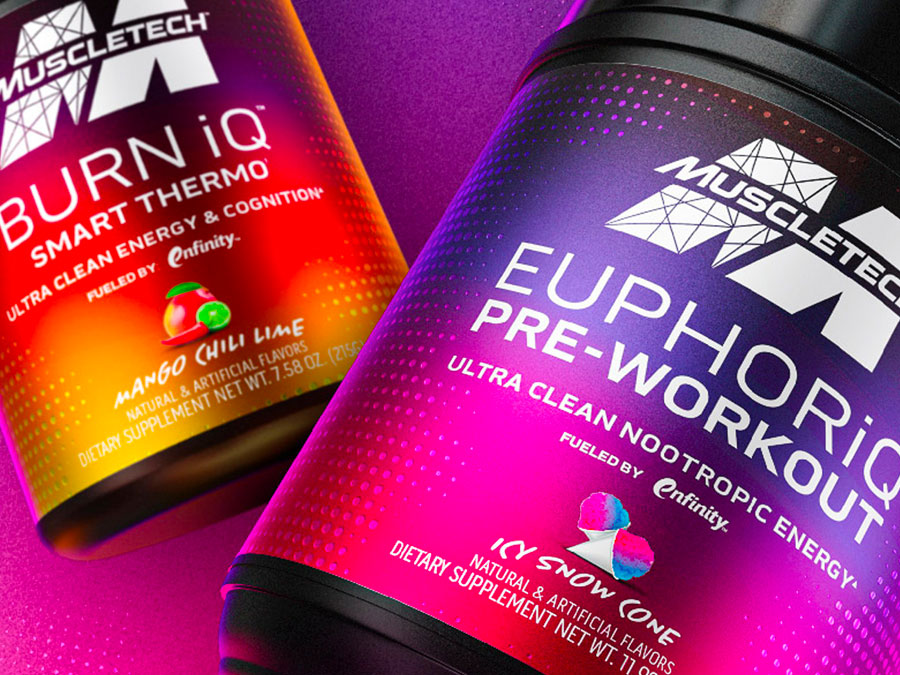By MuscleTech Performance Nutrition Coach Elsie Alkurabi
If we inherently know that the shorthand “calories in, calories out (CICO)” indicates how energy balance influences the gain or loss of body mass, then the solution should be pretty straightforward: “eat at a caloric deficit and you’ll lose weight.”
While this is technically true, one problem with that statement alone is that it gives nothing in the way of actionable advice.
CICO is a concept that seems simple enough — but is, in fact, much more nuanced. For example – while a calorie deficit can deliver fat loss, yes, but it can also rob you of your muscle gains, which means following the same diet you’re currently on in a calorie surplus without making macronutrient adjustments could simply leave you as a slightly smaller, hungrier, but still chubby version of your fatter self.
Table of content
Unfortunately, it’s because these nuances are overlooked we see many feeling frustrated and defeated when they are unable to consistently maintain their diet adherence or get the results they’re after.
What is Volume Eating?
Volume eating is an approach to food consumption that enables one to eat large quantities of food with a low calorie count. This method leverages the varying calorie content of different macronutrients per gram, encouraging the selection of foods that are high in volume. This strategy aids in enhancing feelings of satiety and fullness without raising calorie consumption.
High Volume Vs Low Volume Foods
The caloric density of food, also known as energy density, is determined by its composition and proportion of macronutrients. Foods that are rich in fats or have a high sugar concentration are labeled as "low-volume foods" because fats have over twice the calorie content per gram compared to proteins and carbohydrates. Conversely, "high-volume foods" are those abundant in fiber and water, as both of these components contribute minimal to no calories per gram.
For 1 cup of each:
- Spinach: 30 grams, 7 calories
- Apple: 125 grams, 65 calories
- White Rice: 158 grams, 205 calories
- Avocado: 230 grams, 384 calories
- Olive Oil: 216 grams, 1,910 calories
This comparison uses raw spinach, a raw apple with its skin, cooked long-grain white rice, a raw avocado, and olive oil to illustrate their respective weights and caloric content.
Dieting’s Biggest Hurdle – Hunger
Thanks to information that’s practically everywhere, figuring out a diet plan – including your daily caloric deficit and macronutrient splits is easier than ever. And, with supplements and meal services readily available, hitting those macros has also become a much simpler task.
However, complications start to arise when, even if one is meeting their macronutrient goals each day, they find themselves feeling drained, and ultimately, extremely hungry. The likelihood that their diet will be mentally sustainable in the long run in order to achieve results is low and/or requires an incredible amount of discipline and stress.
To handle this stress, it’s important to understand the manipulation of two hormones in your body – the hunger hormone ghrelin and the satiety hormone called leptin. These hormones have opposing roles in your body.
Ghrelin helps motivate you to eat – as it gets secreted by the digestive tract when your stomach is empty. And as you eat and your stomach starts to fill and the nutrients from the food you’re eating get absorbed, Ghrelin secretion begins to slow down and eventually stop.
Leptin – the satiety hormone, sends signals from your fat cells to your brain that you have enough energy which in turn decreases your motivation to eat. When leptin levels are low, it signals the the brain that fat stores are low and you feel hungry and motivated to eat.
So while “calories in vs calories out,” on its own is sound advice, it does not elaborate on the caloric density of foods, and especially, satiety or satiation which triggers these hormones.
Low levels of satiety after a meal or between them will not only increase the chances you’ll make unfavorable choices when presented to you – especially for those on their first contest prep or novice dieters – but it can also affect things like sleep quality, workout intensity and overall motivation, slowing your results through elevated cortisol and listless workouts.
So, let’s take a step back and talk about bulking up your diet.
Also Read: Get Protein on a Budget
Caloric Density – Bulking Up Your Food Choices
The energy density (or caloric density) of a food is based on its macronutrient content and balance. Proteins are broken down into amino acids, complex carbohydrates are broken down into simple sugars (eventually converted to glucose), and fats are broken down into free fatty acids.
Different macronutrients provide different amounts of calories per gram:
- Protein: 4 calories per gram
- Carbohydrates: 4 calories per gram
- Fat: 9 calories per gram
Satiety is your body’s response to the availability of nutrients from the food that you have already digested and processed.
Satiation is your immediate reaction to the food ingested. That initial cue you get to stop eating.
Think of satiation as a best guess of your future satiety by your body. It makes this estimate based on different sensory inputs like smell, taste, texture, and stomach distension (i.e. how much it expands/stretches).

So what exactly can we take from all this and put into practical applications in order to maximize diet adherence and sustainability?
It’s called Volume Eating.
Volume eating is a concept, strategy, or diet method of prioritizing high-volume foods to help induce satiety and satiation with the resulting intention of reducing overall caloric intake. It ultimately takes into consideration that a food’s physical weight and caloric content are not directly correlated.
For example:
Typically, foods that are richer in fat content are considered “low-volume foods,” given that fat contains more than double the calories per gram compared to protein and carbohydrates.
While lean protein, low sugar carbohydrates, and options high in fiber and/or water content are considered “high-volume foods.”
Focusing on nutrient-dense high-volume whole foods helps to keep you satisfied for longer since most (such as vegetables) are lower in calories per serving, have rich sources of fiber and water, and, quite literally, help to keep your stomach feeling fuller. (4)
When study subjects eat foods low in caloric density (i.e. vegetables) are compared with those consuming foods denser in calories – studies found that those eating higher caloric concentrations consumed twice as many calories per day in order to satisfy their hunger. (2)
Examples of High-Volume Low-Calorie Foods
- Lean protein (Turkey, Chicken Breast, etc).
- Leafy green vegetables (Cabbage, Lettuce, Spinach, Kale, etc.)
- Cruciferous vegetables (Broccoli, Cauliflower, Brussels sprouts, etc.)
- Stem and other vegetables (Peppers, Asparagus, Zucchini, Celery, Cucumbers, etc.)
- Some Fruit (Blueberries, Raspberries, Watermelon, etc.)
- Pickles
- Popcorn
- Rice Cakes
- Soup broth
- Egg Whites
Examples of Moderate-Volume Moderate-Calorie Foods
These options are still high in water and fiber content but moderate in sugar content. Making them slightly higher in calories per serving.
- Fruit (Bananas, Mangoes, Cherries)
- Root vegetables (Beets, Carrots, Potatoes, etc.)
- Whole grains
- Oatmeal (pro-tip: check out Steel Cut Oats).
Another benefit to Volume Eating is that it allows for larger quantities of food consumption. For those who prefer filling meals and the feeling of going to bed on a full stomach, this can be a game-changer psychologically while maintaining a caloric deficit. (1) Not only does it allow for larger portions (bigger, fuller plates of food), but it also helps to increase your intake of fiber, vitamins, and minerals at the same time without much effort. (8)
A 12-week study of 96 women with excess weight and obesity found that meals with a lower calorie density led to decreased cravings, increased feelings of fullness, and reduced hunger (4).
Benefits of High Volume Foods
1. You Feel Full
Concentrating on whole foods that are both high in nutrients and volume can significantly aid in maintaining feelings of fullness and satisfaction. High-volume foods, predominantly fruits and vegetables, are packed with fiber and water. These components are key to promoting satiety because they physically fill up your stomach, helping you feel fuller for longer.
2. You are able to eat more
For individuals who find satisfaction in visually abundant meals, where the bowl or plate appears generously filled, volume eating is an excellent strategy. This approach not only accommodates larger serving sizes, ensuring your meals look ample, but it simultaneously boosts your consumption of fiber, vitamins, and minerals. Thus, volume eating not only caters to the visual aspect of dining but also enhances nutritional intake.
3. Saves You from Calorie Counting
If your objective is weight loss or if you're mindful of your calorie intake, embracing volume eating can revolutionize your dietary approach. Contrary to the common belief that a heaping bowl or plate implies a high-calorie count, volume eating proves otherwise. By prioritizing leafy greens, vegetables, fresh fruits, and whole grains, you're able to indulge in substantial portions without significantly affecting your overall calorie consumption. And since you have picked foods that have a low calorie count, you will not need to feel the urge to have everything written/accounted for.
4. Increases Fiber & Nutrient Intake
Volume eating, with its emphasis on fruits and vegetables, presents a straightforward and highly effective method for boosting your consumption of nutrient-rich, high-fiber whole foods with minimal effort. This approach naturally leads to a diet that's abundant in vitamins, minerals, and fiber, enhancing your overall nutritional profile without requiring significant changes to your eating habits.
The Bottom Line
Higher volume does not always mean higher calories — it all depends on what you are creating that volume with.
Volume eating is an effective dieting tool that focuses on increasing the consumption level of lower-calorie foods. If you consider yourself a “volume eater” it is important to be mindful of portion sizes of low-volume foods, while still allowing yourself the flexibility to enjoy high-volume foods without as much concern.
If you are using a food diary, indulging in ice cream or Oreos occasionally shouldn’t be difficult to add in. The end goal is to put emphasis on staying sane, consistent, reducing hunger pangs, and getting adequate nutrition while in a deficit.
Volume Eating also helps to make you more aware of your eating habits and food choices, so that you can make healthier dietary decisions.
That said, Volume Eating can lead to unintentional limits on healthy fat intake (such as nuts, seeds, avocados, whole eggs, and oils). Not only are healthy fats essential for hormone production, but monounsaturated and polyunsaturated fats may reduce inflammation and protect against chronic conditions such as heart disease.
Key takeaways:
- Fill up on foods with high fiber and/or water content so that you can eat a larger volume of food while staying within your caloric deficit.
- Steer towards foods with a high satiety index. This is where a high protein diet consisting of lean options can be key.
- Don’t sacrifice your nutritional needs. Eggs, avocados, steak, etc. are all still amazing sources of nutrients AND variety. Caloric density isn’t the only consideration.








